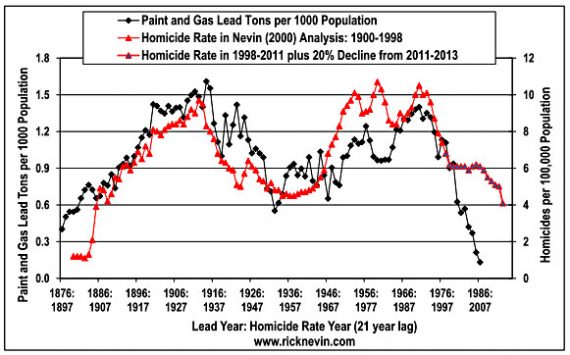U.S. Murder Rate On Track To Be Lowest In More Than 100 Years
Homicide rates are on pace to be lower than they were at the start of the 20th Century.
Kevin Drum links to an interesting study which suggests that, if current trends hold up, 2013 will see the United States experience it’s lowest murder rate in 100 years [Study available in PDF]. Drum, who has been blogging a lot lately about the measurable impact of the removal of lead from the environment starting in the 1970s comments:
Analytically speaking, murder is an especially interesting crime because we have pretty good homicide statistics going all the way back to 1900. Most other crimes have only been tracked since about 1960. And if you look at the murder rate in the chart below (the red line), you see that it follows an odd double-hump pattern: rising in the first third of the century, reaching a peak around 1930; then declining until about 1960; then rising again, reaching a second peak around 1990. It’s been dropping ever since then.
This is the exact same pattern we see in lead ingestion among small children, offset by 21 years (the black line). Lead exposure rises in the late 1800s, during the heyday of lead paint, reaching a peak around 1910; then declines through World War II; and then begins rising again during our postwar love affair with big cars that burned high-octane leaded gasoline. Lead finally enters its final decline in the mid-70s when we begin the switch to unleaded gasoline.
This is powerful evidence in favor of the theory that lead exposure in childhood produces higher rates of violent crime in adulthood.
Here’s the chart that Drum speaks of:
It’s certainly an intriguing hypothesis, and Drum has done an excellent job of making his case in other blog posts on this topic reaching back several months. Of course, it’s probable that the decline in the rate of homicide in particular, and crime in general, over the past several decades is attributable to a number of factors working together. Among those that have been cited as having an influence on criminal behavior. Some researchers have suggested that the legalization of abortion nationwide has been a contributing factor simply because it has prevented the birth of people who would have been raised in environments likely to lead to a life of violent crime. This hypothesis is interesting, but somewhat undercut by the fact that out-of-wedlock and teenage mother births have also increased significantly since the Roe v. Wade decision, and those are precisely the types of environments likely to lead someone to a life of crime. Another factor that many will mention is the manners in which police tactics have changed over the years, but murder strikes me as being an offense least likely to be deterred by something like “community based policing.” The fact that prison sentences for lesser crimes have increased significantly over the years means that people who are likely to commit violent crimes are being kept off the streets for longer periods of time, thus reducing their opportunity to commit more crime. Finally, it may be possible that homicides have declined because medicine has become more skilled at treating people who are injured. For this to be true, of course, one would expect to see a commensurate increase in violent crimes that result in serious, but not fatal, injuries. In the end, though, I’d suggest that all of these factors, including Drum’s argument about the relationship between lead exposure and violent behavior, have played a role in bringing the murder rate to a level lower than it was at the beginning of the 20th Century is an intriguing one. Indeed, if it holds up, then we can expect crime rates to continue to decline as the years go on. That would make the 1970’s era decision to go after a substance that we’ve known from history has adverse effects on human development was a pretty good idea.





Another Obama scandal.
Oh…wait…
Now let’s tackle antibiotics in animal feed … for parallel if not identical reasons.
Countdown to someone tying this to the increase in small arms ownership begins…
@Matt Bernius:
But remember, households with guns fell. They’ll have to tie it to the number of guns in your pockets, rather than you having one, etc.
Well I’m sure we’ll learn the positive lesson from this and start to go after GHGs.
It seems to me that the lead hypothesis is one that can be tested, something for which empirical evidence can or cannot be found. For example, it should be possible to determine where environmental lead levels decreased the most and see if that relates to local decreases in rates of violent crime.
Using national statistics is intriguing but not altogether convincing.
It sounds like you approve of the jack booted thugs from the nanny state EPA taking away my constitutional right to burn whatever I want.
I’m sure Wayne LaPierre will take credit for this with his big idea of everyone being armed!! Oh yes the gun crazies will take credit for this no doubt. All in their minds of course but they can’t see beyond the barrel of a gun as being the answer to everything.
I’d bet on a cluster of factors. Maybe lead, maybe abortion. Also maybe people carrying less cash and more cards makes for fewer armed robberies. Maybe the car culture keeps people more physically isolated and less vulnerable. Maybe the drop in armed households helped. Maybe more violent media actually reduces crime by giving people a fantasy outlet for murderous feelings. Maybe easier divorce laws make it less necessary to shoot your spouse. Maybe the rise of the “whatever” culture makes people less prone to murders of honor or pride. Maybe the presence of more women outside the home. Maybe the rise of marijuana is displacing alcohol.
We can speculate all day.
@Dave Schuler:
I’ve only been casually following headlines, but I believe the correlation is international at this point. Though as described above that doesn’t say it is the only factor.
@this:
Is someone down-voting facts again? Seriously?
Is Doug saying that this instance of heath and safety regulation by Big Gumint was a good idea? Quelle horror! He may get read right out of the libertarian club if he continues any further along that line. Good post, all around.
@this:
Dear idiot down-voter:
That is a big effing drop.
@john personna:
John , John, why do take it so personally re facts? Don’t you know that the right wing crowd makes up its own reality? Of course, they’re going to down vote actual facts. That goes without saying!
Just take a breath and move on, bro. I don’t think they are going to change.
I am surprised no one mentioned the possibility of the role technology plays in this. Everyone carries a phone/camera/Internet/GPS device with them at all times. You can’t get away with anything nowadays without someone having recorded it or reported it via their device + tech increases response times and helps stop things before they happen
@Jc:
“Everyone carries a phone/camera/Internet/GPS device with them at all times.”
Since the majority of the reduction in the homicide rate occurred between 1987 and 1997, I don’t think phone cameras are the best explanation.
@Dave Schuler:
Actually Dave, they’ve done state by state and even city-level analysis of this, and found that the correlation is just as strong:
http://www.motherjones.com/environment/2013/01/lead-crime-link-gasoline
(about 2/3rds down, he links to the studies)
I agree with the discussion above: this is almost certainly multi-variate. There is no … pardon the expression … silver bullet that explain the decline not just in murder but in ALL violent crime, especially sex-based offenses, which are down 60-85% of their peak. Liberalized conceal-carry laws, less lead, more police, longer sentences, etc. I’m also intrigued by suggestions that the increase in pretend violence — movies and video games — sates the violent urges that are in our reptile brains. Those probably all play a role. But I think the biggest factor may just be cultural: that violence has simply become less acceptable in our society. All violence, not just the ultimate violence of murder.
@Hal 10000:
Not to pick on you Hal as others have stated the same, but there is very little evidence of that and in fact most studies indicate the opposite. I recommend this for reading.
When I reached out to five of the country’s most prominent researchers into gun violence, they were uniformly critical of the “more guns” approach and Goldberg’s argument for what they saw as an ignorance of the overwhelming body of social science research that shows unequivocally that more guns equals more deaths. Some used nasty words like “garbage” and “atrocious.”
Also this. Go to page 9 for the relevant section on Right to Carry.
A large body of research has been conducted to investigate the effect of RTC laws on
violence. Most notably, research led by John Lott, Jr. suggests that RTC laws have led to
significant reductions in violent crime. But the research showing crime-reducing effects of
RTC laws, including Lott’s, has been carefully reviewed by a National Council of Research
panel of experts, and others, and has been found to have serious flaws. The most
consistent finding across studies which correct for these flaws is that RTC laws are associated with an increase in aggravated assaults. Using various statistical methods, estimates range from a one to nine percent increase in aggravated assaults as a result of RTC laws.
1-9 % may not sound like much, but with over a million aggravated assaults a year, they add up
@Stonetools:
Normally I do a “dear idiot” post in good humor. The second post, when we are discussing bare facts, just reinforces the uncomfortable truth.
I’ve got to admit that one surprised me yesterday though, and 5 or 6 down-votes on a simple truth takes my breath away.
Who are these people who simply cannot digest the world in a rational way?
@john personna:
I know you will never read this John, but the answer is “True Believer Conservatives.”
so why should there be a war on legal gun ownership? just admit it was pandering, end of story.
@bill:
The statistic is just a truth. All we can say without guessing is that crime and ownership did fall together.
I think the common intuition is that something different happened – that ownership and crime both went up.
@john personna: legal gun owners aren’t the problem, never were. criminals who want to ill will always find a way.
@bill:
First, nowhere above does it say “legal gun owners are the problem.”
But stop to think .. have you ever heard of a legal gun owner who was legal … right up until he was illegal?
In a tragic recent example from my neighborhood a gun owning family man surprised everyone by one day shooting his doctor. What happened there?
Falling violent crime rates cuts against both calls for more gun control *and* against needing a firearm for self defense. And we’ve seen liberalized gun laws + a fall in the % of households with guns. When I googled around on concealed carry studies, it seems the most common result was “likely no impact” – no increase, no decrease.
As for why… I have to think demographics (baby boom) plays a role, I think the lead hypothesis makes sense and plays a role, I think smarter policing/better technology (cameras everywhere?) plays a role, I think it’s even possible that a general society-wide horror at the violence at its peak may have played a role.
I don’t know any of these things. I figure there’s a lot of squish in this.
@Dave Schuler: Drum’s story actually gets into this; the lead issue is the only constant control variable, with all kinds of different policing tactics, socio-economic conditions, and other factors varying, the lead drop was the thing.
Also, its well documented that too much lead makes you…dumb and mean. Clinically, “lowered IQ” and “aggressive.” But dumb and mean will do. And if you have a lot more kids who grow up dumb an mean…you’re going to get more murders.
Read more about how lead affects impulse control here: http://www.wired.com/wiredscience/2011/06/the-crime-of-lead-exposure/